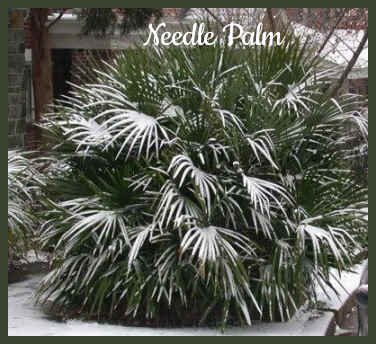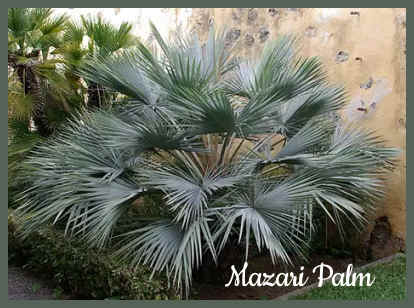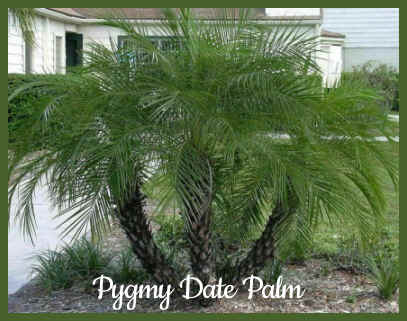|
|
Palm trees make beautiful focal points or accents in your garden, and there are a few dwarfs that cold climate gardeners in zones 5 and 6 can grow. It's easy to combine these with other semi-tropicals in a garden design. I find them beautiful in a tropical garden design, Mediterranean Terrace Garden or as part of a zen, Egyptian or Biblical Garden. It can also be part of a Mary Garden or Secret Garden Retreat. You don't have to live in the tropics or in the deep south to enjoy them, and dwarfs will fit in anywhere. Some enjoy being potted up and spending summers outdoors on patios, terraces and in gardens. It comes as no surprise that global warming means temperatures are increasing across the country. This may promote better results with semi-tropical gardening. It may come as a surprise to many that some gardeners experiment with palms and other plants considered "tropical" in their gardens in states such as New York, , NJ and Ohio, among others. In fact, palms and other semi-tropical plants grow with little or no protection easily. Gardeners who live in states with harsher winters just need to add a little protection to cold hardy palms to keep them in the ground all year round. Mine will be potted and portable, so what the ground does is of no real concern to me. I'll watch long-range evening forecasts, and if blizzards arrive, my palms will keep sheltered for that stretch of time. The real trick is remembering not to make your potted plants too heavy to move or carry. Been there, and it's quite tedious and unnecessary. I use a pot size that I know i can manage on my own after it's filled with soil and plant. If i can't lift it full of just soil, I know I don't be able to carry or lift it when it's planted. You also don't want to make the plant too light. It might blow over, and you might not see it do that in the dead of winter in time to rescue it. All will be mulched at the beginning of the season, so there's really no extra work for me. Weather that affect even cold hardy palms and semi-tropical plants most is wet, cold weather and once or twice every winter (I'm in Zone 6b), we get that arctic blast with temperatures that dip into the single digits and don’t rise much for 24+ hours. Most palms do fine down to 15-30° F. If an arctic blast is probable, bring the plants into a sheltered area. If you planted directly into the ground, which i wouldn't ever do in the northern states, good luck and God Bless. Cover or wrap the plants for the duration. Because of the shape of the fronds, that's not always an easy task without doing damage. And don't forget you'll be freezing your b'hind off while you're doing it. If you decide to add some tropical feel to areas of your garden, it's worthwhile investing in a good-sized plant. First of all, most are slow-growing, secondly, it'll survive the winters easier. Most hardy palms will do okay down to 5 degrees. Unless it's a teeny little thing. Root damage could be an issue on baby plants. Hardy Palm Trees I am only just gtting starting with a few potted ornamental palms to overwinter outside. The info given was given to me. I can't swear to stated Zone 6 palm hardiness, until i've grown them outdoor in pots, myself. Plants that i verify as hardy in my zone are hardy to zone 6, and no argument there. I'm learning along with you. And i remain skeptical until a winter or two passes and the plants survive. I will purchase well-developed plants, to give them the edge over spindly plantlings (my word for it). They will struggle in the heat, struggle in drought, fight bugs and other awful things. Generally, they need the TLC that i don't have time to give. I'll stick with the plants that have been around the block and will forgive some of my inattention. My picks below are the ones I think are the safest cold hardy specimens for zone 6 - that will thrive in my garden. Always check the map. Plants are expensive, so until you know for sure, give your little ones some winter protection and keep them sheltered. In pots, it's no big thing to bring them indoors as houseplants over the winter. They're quite decorative and undemanding. You have the edge over gardeners who put their palm trees in the ground. Portability has saved several of my trees and plants from freezing to death during arctic blasts. Even if they're supposedly cold hardy. Someone says cold hardy in this zone, I say, says who...prove it. Check your hardiness zone map for the plants you'd like, believe your neighbors who grow the same things, and if you take the time to prepare your trees for winter, as you would your home and your outdoor environs, and whether the plants allegedly need it or not, you'll grow some beautiful specimens. |
|
Needle
Palm Tree (Rhapidophyllum hystrix) This is a clump-forming palm, and makes a nice statement in a landscape. The northernmost clump known to be growing without protection resides on Cape Cod. Plants can withstand temps as low as -10°F, but need strong summer heat to thrive. Needle palm tends to survive better on the East Coast (hotter summers) than on the West Coast. The needle palm is very slow-growing and rarely reaches heights of over 3 ft. I think that's perfect for me. |
|
|
|
My PickMazari
Palm (Nannorrhops ritchiana)
|
Windmill Palms (Trachycarpus fortunei, T. takil) Considered one of the most cold hardy palms in the world. The fan palms: (palms with fan-shaped leaves) include all of the hardiest palms. These tough species are native to eastern China, Myanmar, and the Himalaya mountains where severe winter conditions occur.Hardy to about −10 °F, they grow at high altitudes where temperatures are cool. It is also tolerant of low summer temperatures.
|
|
|
|
Bismarck Palm (Bismarckia nobilis)
Native to Madagascar, this cold hardy palm is among the most sought after palms, mainly due to its unique grey color and ability to withstand temperatures down to 15 F. Hardy in zone 8b and above. It is a very fast-growing palm, and can go from 3 to 15 feet in just 5 years in the right environment. During late spring the tree will produce small, fragrant flowers. This tree can grow to 40 feet tall. So keeping it potted will stunt that. This palm produces sharp thorns on the frond stalks, so take proper precautions while pruning. And don't put specimens where your pets can get hurt. |
| Saw Palmetto (Serenoa repens)
This bushy palm is hardy to about 5 °F. Palmettos can handle full sun to complete shade, growing slowly to a typical height of 3 to 6 feet. Perfect for the home gardener, and in pots. This plant grows thick and dense, with no visible trunk, since the base of the plant remains close to the ground.
|
 |
 |
Caranday palm (Trithrinax campestris)
zone 8 and above It is a very rustic palm that grows in arid, well-drained, rocky soils. Its distinctive features are its compact shape, short green to grayish foliage, and trunk fully hidden by dry dead branches (coat) remaining from several previous seasons. It is very resistant to drought, and 25-30 degree temperatures when not in growing season, although it tends to shed its leaves in these conditions. Not the hardiest, but i like compact and drought resistance. In a pot, it can rotate in and out.
|
| Washingtonia palms (Washingtonia filifera, W. robusta) California Washingtonia (W. filifera) is hardy to 10 °F; it prefers a dry Mediterranean climate. It is often grown in containers.
|
 |
|
|
Date Palm (Phoenix dactylifera)
This relative of the Canary Island date palm, and producer of the edible date, is also hardy to about 12 °F, but does not tolerate very wet areas. Always check the USDA cold hardiness map for the proper varieties for your area. Dwarf date palm is relatively insensitive to cold, so it can be kept in gardens , in a pot, or in a bucket without any problems These trees can reach a height of 8 ft. |
|
My Pick Dwarf
Palmetto (Sabal minor ‘McCurtain’) This snow hardy palm hails from McCurtain County, Oklahoma. ‘McCurtain’ grows in Wichita, where it’s known to have survived temperatures of -24°F. It’s a good choice for winter gardeners in places like Ohio, Pennsylvania and Delaware, who want some tropical ambience in their landscapes. This variety ultimately grows to 6 feet and has a faster growth rate than other dwarf palmettos. |
 |
A good combination of plants to grow in your tropical garden theme with the palms in colder climates, are cold hardy varieties of yucca and agave. Intersperse some non-hardies to fill in spaces and add interest, like jade trees, and a hardy dwarf variety of clumping bamboo (non-invasive, evergreen in my zone 6 garden). All grow indoors as houseplants, so these non-cold hardy can be brought in before winter. Palm Care Planting When planting in a container, select a pot with drainage holes on the bottom and one that's 2 to 3 times the size of the root ball, leaving room for those roots to get established. While your tree is growing up, it’s important that you water it frequently to help the roots form. You should water your tree at least 2 to 3 times per week, or more if you live in a drier climate. After the roots develop a sturdy structure, you will only need to water an adult tree two times a month.. The only time you should prune your tree is when the fronds are discolored or broken. Palms get most of their energy from their fronds. In winter: If you want to (I don't) cover every plant, there are several ways of doing it. I'll just move my pots into a sheltered place on my patio, or in the house, as houseplants until spring. If you do move your plants, you might have to water them now and then, if they don't get precipitation where you put them. If you grow in pots, there are large plant protection bags with a drawstring. Put the bag on the ground, move the pot and place it on top, then pull the bag over the pot and soil, as far as it goes up, and tie it with the drawsting. If you have a bag big enough, you can start from the top of the plant and pull down.... they come in many sizes. You can protect them with a heavy mulching, plant protector bags, or lots of bubble wrap and leaves wrapped in burlap. On the soil and up the trunk a bit. Don't cover the leaves on the plant. If you're wrapping or mulching, do it on as much of the plant as you can, considering it's shape and width. try not to lay the fabrics or plastic tightly over the leaves. Wet plant leaves all winter will create a bit of rot. Poke 4 ft. + plant stakes into the pot to keep the leaves from getting scrunched and too wet. Cover with, and poke the burlap down into the soil, with 6 inch landscape fabric pins. Snow cover with be heavy enough on top of the pot that to keep the soil and roots protected. And snow cover is really beneficial to the plants because it's an insulator. You want a good snow cover in the garden all winter. The palm could be be treated with an anti-desiccant such as Wilt Pruf, which will help the plant hold water in freezing conditions. The key to helping your palms in the winter is to keep them as dry as possible (especially the crown, where damage may be fatal). It would even be beneficial to water the plant with warm water after long periods of dry or freezing weather. It used to be called an old wive's tale, but the truth is that water is an insulator, and it gives off heat, preventing most roots from freezing to death. They don't have time - if there hasn't been much rain before a freeze, I water them. I keep a close eye on things especially in spring. If a late hard frost is coming after things begin to bud and grow, i make sure the plants have had enough water to avoid being frozen, and i cover them for the day or two until temps go back up above freezing.
Quick Links
Content, graphics and design ©2021 marysbloomers.com |





